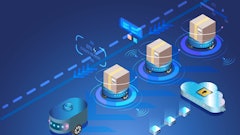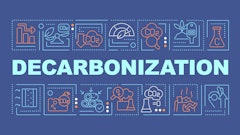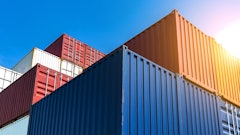
2024 is projected to be the year for major adoption and implementation of warehouse automation.
Thankfully, these true problem-solving solutions are prepping cold food chains for anything and everything.
Food Logistics talks exclusively with Jim Hoefflin, CEO, Softeon, about how automation subsystems help supply chain companies fill a need in their whole ecosystem.
CLICK HERE to read the article in full.
Food Logistics: Warehouse automation continues to be on the rise. What do you think is attributing to the growth in adoption of automated warehousing?
Jim Hoefflin: Robotics isn't a trend for trendsake. Robotics is about trying to fill a gap. Warehouse execution and creating more efficient flow is about trying to create, just trying to fulfill a gap. And that gap is the labor gap. The work one used to be able to do by plugging in a few extra people, can't be done anymore. Labor challenges open up and change the economics of a lot of different inventions. So, a lack of a human workforce is the driver, and it permeates through other dimensions of dealing with solutions, for example having a gap in an operational setting on the operations floor, and a gap of labor in it, infrastructure, business analysts, people that will deploy and support systems. So, the customers are trying to figure out how to efficiently run a business - supporting all areas of the operation - without having the human workforce they used to have.
If you look at the last 10 years, automation and robotics were in more of an infancy stage, but now the sectors have accelerated because everything has shifted; people have to find solutions. The truth of the matter is, those solutions are still early, and they are improving rapidly. So, what our buyers need to be aware of is that they have to look at automation subsystems as much as possible as large operational components that fill a need in their whole ecosystem.
Food Logistics: What kinds of automated solutions/technologies has your company introduced within the last 12 months? Anything on the horizon that will be introduced soon?
Hoefflin: Within the last year, Softeon has introduced its latest WMS/WES upgrade which includes robotic interfaces and other automation implementation options designed to address the growing customer investment and innovation in warehouse automation. Additionally, we’re announcing more of our capabilities and how we’re enabling many of our customers to successfully establish fully automated warehouses using our WMS.
Food Logistics: What advice do you have for those companies who haven’t implemented any automation whatsoever or are just starting the journey? Where/how should they start?
Hoefflin: When a supply chain leader says they don't have the people in place that they used to have to do a lot of the necessary work, they understand very quickly that they have to cover that need with automation subsystems, machine learning, large language models, and artificial intelligence that will learn and identify things. For leaders who are considering the implementation of automation, I tell them they must figure out their needs. Are they adding autonomous mobile robots and other hardware to do the work? If so, they need to integrate and orchestrate all of the work being completed by utilizing automated technology, like a WMS and WES. They need a platform for handling warehouse data and processes that enables orchestration across various devices and systems on the warehouse floor. For best success, they need a composable platform that provides a comprehensive, bird’s-eye view of warehouse operations and enables data-driven decisions, so we know when we need to pivot if work becomes unbalanced or if we need to manage order fulfillment peaks, for example.
Food Logistics: How can companies decipher which automated solutions are best for their warehouses?
Hoefflin: Supply chain leaders looking to find the right warehouse solution must consider the capabilities and ultimately those vendors that philosophically align to the rest of the solution that you have in your ecosystem and be able to leverage it without a lot of handholding and a lot of people internally that are going to build integrations or build reports. You have to get to that actionable intelligence more rapidly. And then you look at that and you go to that next level of just managing and making sure those solutions are super resilient. So maybe you used to have an IT staff that could watch things across a bunch of systems. Well, now you have to have vendors and platforms and technology that is monitoring and understanding when it's got a problem.
In the next decade and beyond, customers are going to be looking at how to find the ideal half a dozen systems and then put them together in their ecosystem for tailoring solutions to their needs. Opposite of the last 30 or 40 years, for the first time we have all of this interoperability and connective tissue between systems that really eliminate the impedance of moving data back and forth. Warehouse management must understand their current and future needs to find the right tailored solution to help them get quality, efficient work completed, all while using and providing data insights that allow the operators to make well-informed decisions.
Food Logistics: In your opinion, which are the best types of automated solutions and why?
Hoefflin: Think AI, cloud-based, IoT, connectivity and more. The most needed types of automated solutions are those that are truly tailored to meet the needs of the user. We're at this inflection point between what the philosophy used to be about building big broad platforms, and finding the best, most optimized, composable solutions or solution sets that map to the customer’s operation. Looking to the immediate future and beyond, I think customers are going to recognize that they need to decompose their business problem down into a little bit narrower band. Now, what you need to do is weave together these different areas of systems into one single flow that maps to what the operation needs. A lot of people are talking about it, and they call it composability. The best automated solution will be around the most compatible, flexible and scalable integrated suite of resources.
Food Logistics: What are some things not addressed above that may be pertinent to our cold food chain readers?
Hoefflin: Composability means that you can take feature functions from different areas and you can kind of bring them together in a single workflow and do it without any coding. You do it through configuration or however you stitch it together, but it's a low code or no code technology set, which we bring to bear to our customers. So that gives that extra productivity and does it in such a way that you can get it done for very inexpensively and very quickly, because it's about speed to market, too. When you look at the operations and how people are changing, you need to be able to map to these operational flows, or bring new technologies to the warehouse, or react to your changes in days or weeks, not months and years.
CLICK HERE to read the article in full.


























